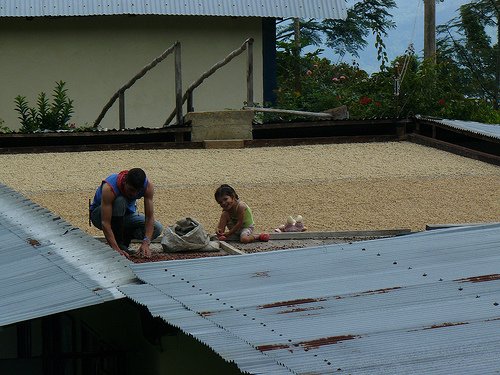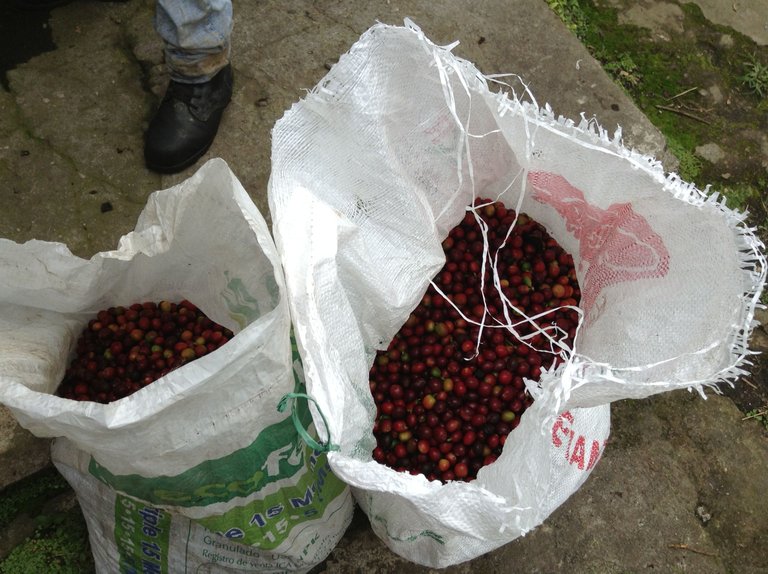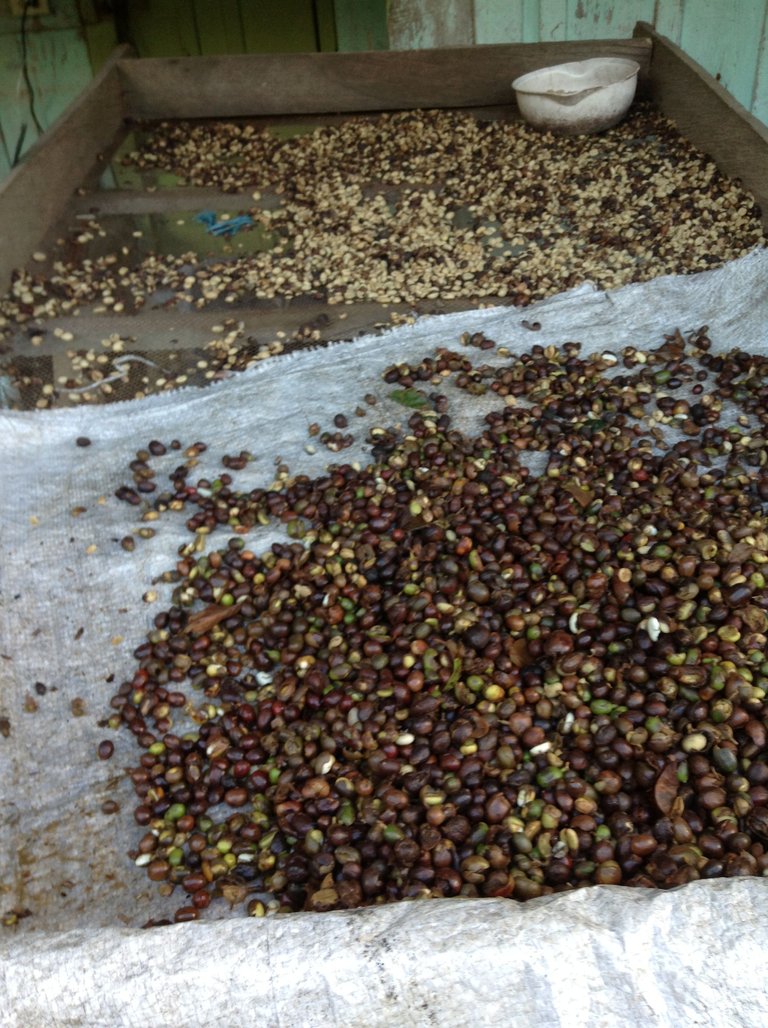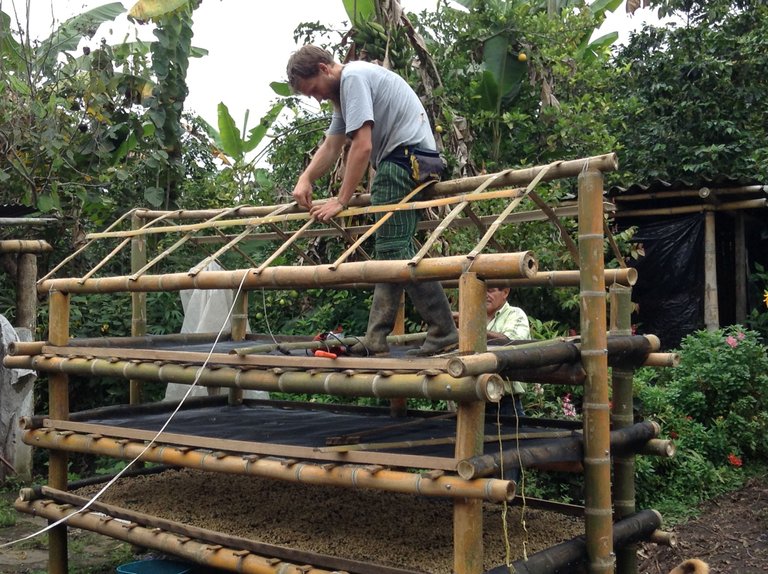My name is Alex E.B. Trapp and I am working on ways to transition monoculture coffee crops to more sustainable agroforestry systems. In 2013 my wife and I bought a small piece of land in a coffee growing region of Colombia, and immediately began learning new things about coffee and its production chain.

This is a part 2 of an anticipated 5 part series on the TRUTH about coffee.
Read Part 1 here: https://steemit.com/coffee/@ecoinstant/the-truth-about-coffee-part-1
Recently I was featured on the Minnow Accelorator Project number 9, or MAP9. Head on over there and give me an upvote if you are willing: https://steemit.com/minnowsupport/@accelerator/six-of-the-best-map9-minnow-contest-vote-now-win-upvotes
Thanks for reading :P
Part 2: …to fermenting the beans….
Coffee beans are hand-picked and harvested using waist-hanging baskets and then dumped into sacks. During peak harvest its possible to pick more than 100 kilograms of ripe coffee beans in one day, but only if you are experienced. During a non peak harvest, 40 to 50 kilos is a good day.
Anecdotally, I can report that coffee picking is not as easy as it seems. Early on, we offered to a close friend who was visiting an offer that we had seen other homesteading farmers use, room and board in exchange for work, and that work was picking coffee.
We soon realized that this inexperienced friend was picking so few coffee beans, less than 5 kg per day, that he wasn’t even getting close to ‘earning his keep’. But we continued to learn, and because of that adventure I can tell you that to break even when offering just food, the worker needs to pick at least 20 kilos that day.
These sacks are then carried up to the hacienda to be shelled in the wet mill.
A what?
A wet mill. The wet mill, or decerezadora, shells the pulpy red fruit from the beans and spits them out on one side, and drops the sticky beans on the other side. It took me a while to figure out exactly what this machine is doing, and how it works, but I will reveal all to you, my friendly followers!
Between the bean and the fruit there are two layers. The first is a layer of parchment, a papery substance that surrounds the hard inner bean. Outside of that there is a layer of mucous, a substance that is simultaneously extremely slippery and sticky. A red bean, well-aimed and well-squeezed can shoot its seed several meters at an unsuspecting friend or other target.
When the wet mill turns its drum, the teeth of the drum force the beans into a narrow corridor, too narrow for even one full bean to pass. This bottlenecking creates pressure and the coffee seed shoots out one side, the teeth of the drum carrying (most of) the red fruit to the other side, thus separating the two different substances.
These inner pits of the coffee fruit are now covered only in parchment and mucous. They are left to stew in their own juices, as it were, for 12 to 18 hours, most commonly overnight.
During the night, the mucuos ferments, transforming with the help of many types of microorganisms, and in the morning can be washed off.
This traditional method of shelling the beans, fermenting and then washing them has led to some ecological problems. In huge haciendas, working with hundreds of thousands of coffee plants, the large amounts of fermenting coffee mucous being let directly into the water supply has had noticeable effects. Currently a campaign exists within the National Federation of Colombian Coffee Growers to use septic tanks and other processes to help clean the waste from this process before the water makes it back to the watershed, usually streams or rivers.
After washing the beans, they must be selected. Using a mesh, only the beans that have been fully separated from the fruit will pass through.
The rest of the half-shelled beans can be dried separately and sold or used to make a lower quality coffee beverage. Locally this is called pasilla, and we’ll discuss this more in a future article.
Now the beans are ready to dry. Sun dried coffee beans are a traditional commodity product world wide. The international community has made great efforts at analyzing and improving the process of drying coffee. It is much more difficult than it seems.
In the high mountains, rain can come at any time. A quick sprinkle and all progress can quickly be lost if you aren’t able to bring in the coffee beans in time. For several months we struggled, hauling heavy sheets in and out trying to dry our coffee. It can take up to ten days in optimal conditions to dry coffee to roasting specifications, commodity brokers don’t consider coffee dry until it has less than 12% relative humidity. Of course it takes much longer to dry in suboptimal conditions.
And as we continued to learn about coffee, we continued to harvest more and more coffee.
Traditionally rural Colombians designed a type of sliding roof with a layer of boards underneath that could be used to rake out the coffee beans. When rain threatened, they could quickly slide the roof closed until the storm passed. Here's an example:

But a sliding roof requires a bit of ingenuity and more than a few dollars, especially if you’re not sure if your house can even support the weight.
So, we built a drying hut.
Locally called a marquesina, these drying racks are set under a piece of plastic so that they stay dry during the rain, and continue to slowly dry over time. Raking the beans out ensures that they dry evenly.
At first the beans are visibly wet, and the parchment fits tight over the bean. If you scratch off the parchment at this stage you will see the coffee bean is a ivory white. As the beans dry, the bean takes on a greyish color and all visible water will disappear.
Once the bean is below 12 % relative humidity the parchment will be dry and flaky, and the bean will be hard, so hard that even biting with your teeth a mark will not be left. The beans are now ready to roast or to sell, these are Commodity Beans refered to in global prices.
One carga of commodity beans weighs 125 kilograms, fits in 2 large coffee sacks, and is also the maximum load for a mule to carry. These beans are muled in from all over the Andean mountains to the Coffee Federation, aka Juan Valdez, who takes care of the majority of the national coffee profits for us.

We will take a deeper dive into the global coffee market in a future article. Thanks for reading! All upvotes and resteems are heartfelt and greatly appreciated, but what I love most of all are the comments. Ask, muse, opine, critique and generally participate with me in the comments!
Remember to head on over and check out the MAP9, and of course give me an upvote if you are willing!
https://steemit.com/minnowsupport/@accelerator/six-of-the-best-map9-minnow-contest-vote-now-win-upvotes
Source: All images, unless otherwise stated, are property of and sourced from myself, Alex EB Trapp, and/or my wife, Ledis Arango V.
Exceptions:
Coffee Elba: http://www.proaves.org/productive-alternatives-for-conservation/?lang=en
Mules with Coffee: Image taken from video; youtu.be/qsamYBcq_QU

















Hello. Amazing information about coffee Would you be able to export your blend ?
Indeed we do! You can check it out at qetamerica.org Any problems with the website let me know here on steem.
Do you produce Espresso blends ?
I had to answer this question in an article! Thanks for inspiring me!
https://steemit.com/coffee/@ecoinstant/the-truth-about-coffee-bonus-part-3-1-espresso
What a fantastic post Alex. Thank you for using the SteemitBC tag! I will have to pick up some of your coffee as well!
We are living in a coffee farm, we know what you just said but are curious about actual roasting and pruning, cheers, bub
Thanks for the comment, coming soon in the series, part three is roasting. I hadnt thought about pruning, I will go through my pictures and gather my thoughts, for now I can tell you that the branches make great firewood!
sir you are really a great person.you love you job and you are hardworking man.God bless you
Thank you so much! Blessed are the hardworking :)
Wow, thank you for so much detailed information! And the photos look awesome. I love your drying rack. Bamboo structures always fascinate me.
Just found you through someone's re-steem and have been going back and reading your older posts. I love hearing about your farm experiences and learning so much about my coffee!
Thank you! I love to drink coffee and it also has such an interesting process.
Thanks for this very detailed post.
I enjoyed reading it.
I've read/heard a bit about molds introduced to coffee in the wet processing and drying . Is this much of an issue, in your opinion, or is it over hyped?
I will look into it! Thanks for reaching out :)
what a hard work, keep it up! you have one new follower here.
Love reading about this. Specialty coffee is getting big here in the Philippines. I got friends who roast coffee from all over the world and from local farms. It's so cool to see the daily grind of the farmers who make make our daily grind ;)
Nice post, beautifully presented and explained. detail oriented with nice pics. thank you for sharing this with us, Upvoted
Congratulations @ecoinstant!
Your post was mentioned in the hit parade in the following category:
I certainly like coffee, and your blogs about it a real fun pleasure to read. thank you for the information, Hope all goes well for you and the missus.
thank for sharing
Thanks for sharing!
Awesome work, you've got a new follower here. Upvoted.